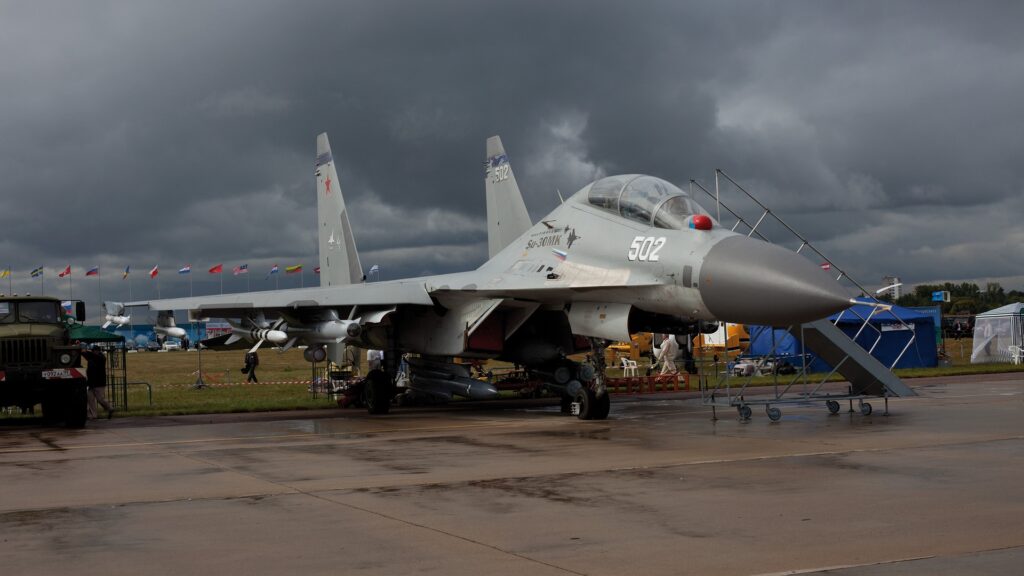Su-30 MKI History and Developments
The SU-30 MKI, a powerhouse in the Indian Air Force‘s (IAF) fleet, traces its origins to the Russian Sukhoi Design Bureau. The collaboration between India and Sukhoi began in the late 1990s, leading to the development of a customized variant specifically tailored for the IAF’s needs. The acronym “MKI” denotes “Modernized Commercial Indian,” highlighting its adaptation for the Indian context.

Facts and Figures:
- Derivative of SU-27: The SU-30 MKI is a derivative of the SU-27, part of the renowned SU-30 family of aircraft. Its design incorporates elements from the Soviet-era SU-27, showcasing a lineage of proven capabilities.
- Twin-Seat Configuration: Featuring a twin-seat configuration, the SU-30 MKI enhances operational flexibility and serves training purposes, making it an effective platform for skill development and mission planning.
- Maximum Speed: With a maximum speed of 2,120 km/hr (Mach 2), the SU-30 MKI boasts exceptional speed, enabling swift responses and maneuverability in various combat scenarios.
- Range: The aircraft’s combat radius allows for extended missions, covering vast distances without compromising performance. This extended range contributes to its strategic effectiveness.
- Weapons Arsenal: Armed with a formidable 30mm GSH-30-1 cannon, the SU-30 MKI is equipped with an extensive array of weaponry, including air-to-air and air-to-ground missiles, precision-guided munitions, bombs, and rockets.
- Avionics Suite: The aircraft features a sophisticated avionics suite, incorporating advanced radar systems, communication equipment, and navigation tools. This high-tech suite enhances situational awareness, communication, and mission execution capabilities.
- Role Adaptability: The SU-30 MKI stands out as a multirole fighter, excelling in air superiority, ground attack, and reconnaissance missions. Its versatility allows it to seamlessly transition between roles based on mission requirements.
Role in the Indian Air Force:
- Adaptability and Versatility: The Su-30 MKI excels as a multirole fighter, showcasing unparalleled adaptability in various combat scenarios. It is equally adept at air superiority missions, ground attacks, and reconnaissance, making it a versatile asset for the IAF. This adaptability is crucial in addressing the dynamic and evolving nature of modern warfare.
- Indo-Russian Collaboration: One of the unique aspects of the Su-30 MKI is its genesis in the collaboration between India and Russia. The aircraft is a result of joint development, combining Russian design expertise with Indian specifications. This collaboration has not only strengthened bilateral ties but has also led to the creation of a cutting-edge fighter tailored to meet India’s strategic needs.
- Air Superiority and Dominance: The Su-30 MKI stands as a guarantor of air superiority, ensuring that the Indian skies remain under the control of the IAF. With its exceptional speed, maneuverability, and advanced avionics, it can outperform and outmaneuver potential adversaries, establishing dominance in aerial engagements.
- Ground Attack Capabilities: Beyond air-to-air combat, the Su-30 MKI is equipped for ground attack missions. Its precision-guided munitions, sophisticated avionics, and powerful weaponry make it a potent force in striking ground targets with accuracy. This dual-role capability enhances the IAF’s operational flexibility.
- Strategic Reach and Endurance: The aircraft’s impressive range and endurance contribute to India’s strategic reach. Capable of covering vast distances without compromising performance, the Su-30 MKI ensures that the IAF can swiftly respond to potential threats, both regionally and beyond.
- Deterrent Effect: The Su-30 MKI serves as a deterrent, dissuading potential adversaries and reinforcing India’s defense posture. Its imposing presence, coupled with advanced technology and firepower, sends a clear message about the country’s commitment to national security.
- Operational Asset in Electronic Warfare: In addition to its primary roles, the Su-30 MKI serves as an operational asset in electronic warfare. Its electronic countermeasures and capabilities to disrupt enemy radar systems contribute to its effectiveness in complex battle scenarios.
- Human-Machine Synergy: The aircraft’s design incorporates features that enhance the synergy between the pilot and the machine. Its advanced cockpit, user-friendly interface, and ergonomic design contribute to the pilot’s situational awareness and responsiveness, ensuring optimal performance in high-stakes situations.
In summary, the SU-30 MKI stands as a testament to the successful collaboration between India and Russia, representing a technological marvel and a cornerstone of the Indian Air Force‘s operational capabilities. Its combination of speed, firepower, and versatility positions it as a key player in ensuring national security and defense.